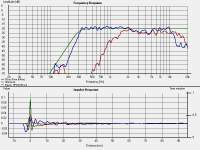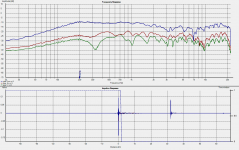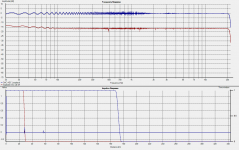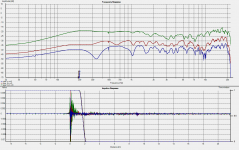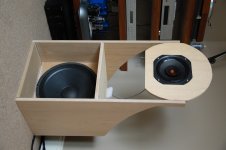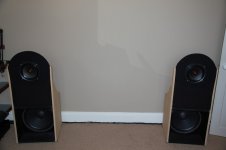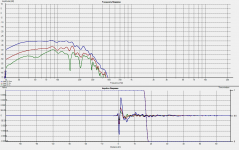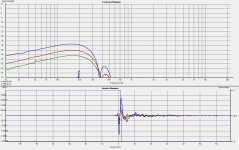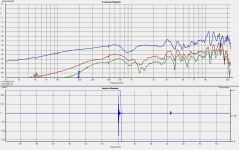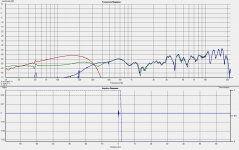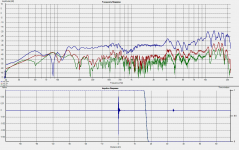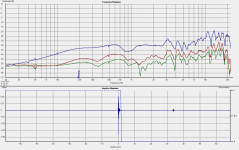You need to have a file specific to your ECM8000. i have 3 calibrated ones and the curves are all different
dave
dave, the problem is that nobody Argentina calibrated mic and send it to USA I would very expensive, any curve tested in the HOLMImpulse be better than nothing.
Not for professional use, only hobbyists
Best regards
Osvaldo
Panasonic WM-61A capsule question
Will I have to build a preamp in order to use Panasonic WM-61A capsule? I want to use it on Dell M1330 Laptop that uses SigmaTel soundcard. Can I just solder this capsule to cable that goes straight to 3.5mm microphone jack in front panel? Currently I am using HolmImpulse with built in laptop microphone and it works however looking for accurate measurement.
Will I have to build a preamp in order to use Panasonic WM-61A capsule? I want to use it on Dell M1330 Laptop that uses SigmaTel soundcard. Can I just solder this capsule to cable that goes straight to 3.5mm microphone jack in front panel? Currently I am using HolmImpulse with built in laptop microphone and it works however looking for accurate measurement.
Where do I place the microphone when measuring the nearfield response of a speaker having a phase plug?
I believe that this question has been asked before, but I haven't seen a reply so I'll give it another go. I have always measured nearfield response by placing the microphone about a cm from the middle of the cone. It is not intuitive to me that this is the right place for a phase plugged speaker. D'Appollito doesn't cover this situation in his book.
Thanks.
I believe that this question has been asked before, but I haven't seen a reply so I'll give it another go. I have always measured nearfield response by placing the microphone about a cm from the middle of the cone. It is not intuitive to me that this is the right place for a phase plugged speaker. D'Appollito doesn't cover this situation in his book.
Thanks.
Where do I place the microphone when measuring the nearfield response of a speaker having a phase plug?
I believe that this question has been asked before, but I haven't seen a reply so I'll give it another go. I have always measured nearfield response by placing the microphone about a cm from the middle of the cone. It is not intuitive to me that this is the right place for a phase plugged speaker. D'Appollito doesn't cover this situation in his book.
Thanks.
I would have thought in the middle of the front plane of the speaker.
If I remember correctly, up to the dustcap within a distance one tenth of the diameter of the cone. In practice it is possible to get the mic very close and I usually go within one centimetre.
Where do I place the microphone when measuring the nearfield response of a speaker having a phase plug?
I believe that this question has been asked before, but I haven't seen a reply so I'll give it another go. I have always measured nearfield response by placing the microphone about a cm from the middle of the cone. It is not intuitive to me that this is the right place for a phase plugged speaker. D'Appollito doesn't cover this situation in his book.
Thanks.
Hi,
My best guess would be just in front of the phase plug. Rememrber that nearfield is only usefull for measuring low frequencies = long wavelengths were the phase plug does not have any effect.
Panasonic WM-61A capsule question
Will I have to build a preamp in order to use Panasonic WM-61A capsule?
I have just set one of these capsules up, I copied this easy circuit;
Gainphile: Cheap and accurate speaker measurement
And downloaded a calibration file from here;
Mad About Sound | Panasonic Mic Electret WM-61A
If you search this diyaudio, you will come across other calibration files in other formats.
I am reading this thread just to get a grip on measuring.
Can i post up the results and get an opinion?
Cheers
Ian
Yes, please do. You can save the graphs in PNG format out of HOLM, it works very well. Then use the attach file function here. See my example below.
In HOLM go to the FILE drop down and look near the bottom. Click the "resize graph area to 800x600". The on the same file menu you can choose what to save. Use the compressed png option.
.
In HOLM go to the FILE drop down and look near the bottom. Click the "resize graph area to 800x600". The on the same file menu you can choose what to save. Use the compressed png option.
.
Attachments
Yes, please do. You can save the graphs in PNG format out of HOLM, it works very well. Then use the attach file function here. See my example below.
In HOLM go to the FILE drop down and look near the bottom. Click the "resize graph area to 800x600". The on the same file menu you can choose what to save. Use the compressed png option.
.
Here goes!
This is my first set after reading through loads of threads;
My Gale mini monitors, measured at 10cm, .5m and 1m.
Do these look sane & did i get the Panasonic mic working ok?
Tomorrow I should get a change to upload some measurements of my H fame + audio nirvana super 8 mash up i have built, so you guys can help me tune them 😉
Cheers
Ian
Attachments
Yep, that works!
Hard to know if you got the mic cal right, but it doesn't look too bad. If you can do a loop measurement - soundcard out to soundcard in - and leave the mic cal ON (normally you wouldn't) then it should show up in the loop measurement. Turn it off and run another sweep and you should see a flat line.
Don't forget to set your HOLM graph size to 800x600, no need for larger.
One strange thing about your measurement, see that big second impulse at about 33 meters? That's about 96 mS. Is that a real reflection, or some sort of electrical or computer crosstalk?
Hard to know if you got the mic cal right, but it doesn't look too bad. If you can do a loop measurement - soundcard out to soundcard in - and leave the mic cal ON (normally you wouldn't) then it should show up in the loop measurement. Turn it off and run another sweep and you should see a flat line.
Don't forget to set your HOLM graph size to 800x600, no need for larger.
One strange thing about your measurement, see that big second impulse at about 33 meters? That's about 96 mS. Is that a real reflection, or some sort of electrical or computer crosstalk?
Hi Pano,Yep, that works!
Hard to know if you got the mic cal right, but it doesn't look too bad. If you can do a loop measurement - soundcard out to soundcard in - and leave the mic cal ON (normally you wouldn't) then it should show up in the loop measurement. Turn it off and run another sweep and you should see a flat line.
Don't forget to set your HOLM graph size to 800x600, no need for larger.
One strange thing about your measurement, see that big second impulse at about 33 meters? That's about 96 mS. Is that a real reflection, or some sort of electrical or computer crosstalk?
I Have done a load of measurements, including loopback & re measured the Gale speakers.
I am not sure about the 96ms impulse. I re calibrated everything and adjusted the sound card. I dont think it is a real reflection.
The room dimensions are;
Room LxWxH 410x340x190 cm approx
What do you think?
Thanks
Ian
Attachments
Last edited:
My Open baffle first measurements
Hi All / Pano,
Here are my DIY open baffle speakers;
They are Eminence Beta 15 in a 40cm sq H fame powered by a Dayton plate amp with adjustable gain &Hz - 180Hz crossover.
Above is an Audio Nirvana super 8 full range, with no crossover, driven by low powered valve amps.
Hi All / Pano,
Here are my DIY open baffle speakers;
They are Eminence Beta 15 in a 40cm sq H fame powered by a Dayton plate amp with adjustable gain &Hz - 180Hz crossover.
Above is an Audio Nirvana super 8 full range, with no crossover, driven by low powered valve amps.
Attachments
Open baffle measurements
Here are my first measurements;
Both drivers measured at 10cm, .5m, 1m distance.
But i wasn't sure how to gate the beta15, so i used 200Hz & 20Hz.
Here are my first measurements;
Both drivers measured at 10cm, .5m, 1m distance.
But i wasn't sure how to gate the beta15, so i used 200Hz & 20Hz.
Attachments
Now the combined drivers;
So now I would like some help.
I really don't know how to tune the speakers, or what to do with this data?
I can adjust the output of both amps individually, and the plate amp has a 40Hz - 180Hz filter.
Other options;
I can change the baffle of the audio nirvana super 8's, Enable them. add passive components. but i came to this design from a large rectangular baffle, and this small baffle improves the imaging / sound stage. But may be adversely effecting the frequency response?
Any suggestions please?
Thanks
Ian
So now I would like some help.
I really don't know how to tune the speakers, or what to do with this data?
I can adjust the output of both amps individually, and the plate amp has a 40Hz - 180Hz filter.
Other options;
I can change the baffle of the audio nirvana super 8's, Enable them. add passive components. but i came to this design from a large rectangular baffle, and this small baffle improves the imaging / sound stage. But may be adversely effecting the frequency response?
Any suggestions please?
Thanks
Ian
Attachments
I am about to make some measurements of the frequency response of my car-audio. It is off course not hi-end and I don't need hi-end measurements. Therefore:
- What soundcard would you all recommend at a resonable price? I hope it is possible to find a decent card below 200-300 $. My labtop is a Lenovo W500.
- Is it possible to use a CD or a SD-card for the sound/noise? My car-audio is without line-in.
- Where can I download the correction-file for the Behringer ECM8000 microphone?
Thanks a lot.
- What soundcard would you all recommend at a resonable price? I hope it is possible to find a decent card below 200-300 $. My labtop is a Lenovo W500.
- Is it possible to use a CD or a SD-card for the sound/noise? My car-audio is without line-in.
- Where can I download the correction-file for the Behringer ECM8000 microphone?
Thanks a lot.
Hi!
It's a really great piece of software! Unfortunately my computer or microphone seems to be severely limited at 7kHz and above :-( but here are some results. The sweep is on the fast side, which I'm sure doesn't lead to accuracy . . . but it's a useful piece of software:
Systems:
Tannoy Lynx 12 inch unit (akin to Gold) in vintage cabinet

Tannoy Monitor Gold 10 inch

Tannoy DC100 8 inch gold unit with traditional horn tweeter

Tannoy Sixes 609 with waveguide tweeter horn

Manger Zerobox 103

Lowther PM6C in Acousta cabinet

Lowther DX4 in 150Hz tractrix horn

Lowther EX4 in 150Hz tractrix horn

Void Basys including subwoofer

Cheap 10 watt full range unit in 150 Hz Tractrix horn

VOTT - TOA Altec Voice Of The Theatre:

Single Units:
8 watt 8 inch cheap unit:

15 watt 8 inch unit:

Monacor 6 inch

Monacor 4 inch

Eagle 6 inch

Eagle 4 inch

Best wishes
David P
It's a really great piece of software! Unfortunately my computer or microphone seems to be severely limited at 7kHz and above :-( but here are some results. The sweep is on the fast side, which I'm sure doesn't lead to accuracy . . . but it's a useful piece of software:
Systems:
Tannoy Lynx 12 inch unit (akin to Gold) in vintage cabinet

Tannoy Monitor Gold 10 inch

Tannoy DC100 8 inch gold unit with traditional horn tweeter

Tannoy Sixes 609 with waveguide tweeter horn

Manger Zerobox 103

Lowther PM6C in Acousta cabinet

Lowther DX4 in 150Hz tractrix horn

Lowther EX4 in 150Hz tractrix horn

Void Basys including subwoofer

Cheap 10 watt full range unit in 150 Hz Tractrix horn

VOTT - TOA Altec Voice Of The Theatre:

Single Units:
8 watt 8 inch cheap unit:

15 watt 8 inch unit:

Monacor 6 inch

Monacor 4 inch

Eagle 6 inch

Eagle 4 inch

Best wishes
David P
HW/SW question
You guys are doing some interesting things here!
I have been searching and searching for software, and hardware, that will play nicely with one another. This HOLM software I find to be a possibility for my needs, but as I read through the the last few pages of this thread I am wondering what type of interface are some of you using to grab some of these signals?
I am just looking for some direction for which interface is suitable, and sw too!
Interesting topic!
Thanks for any help!
Marci
You guys are doing some interesting things here!
I have been searching and searching for software, and hardware, that will play nicely with one another. This HOLM software I find to be a possibility for my needs, but as I read through the the last few pages of this thread I am wondering what type of interface are some of you using to grab some of these signals?
I am just looking for some direction for which interface is suitable, and sw too!
Interesting topic!
Thanks for any help!
Marci
Hi,
I'm using an M-audio 2496 pci sound card and a DIY Panasonic wm 61 mic capsule.
Gainphile: Cheap and accurate speaker measurement
Gainphile has written a great article.
Good luck
Ian
I'm using an M-audio 2496 pci sound card and a DIY Panasonic wm 61 mic capsule.
Gainphile: Cheap and accurate speaker measurement
Gainphile has written a great article.
Good luck
Ian
software and interface
Myself being a newbie to this audio analysis, I think this HOLM s/w seems to be a good jumping on s/w product for me to begin with. However, with that decision out of my way I can now fully devote my dwelling time to deciding on a h/w interface. M-Audio seems to be a name that has products that are marketed quite heavily, but as many purists are fully aware, so are Bose products. Despite M-Audio's heavy marketing I spent a few moments on their driver update page and it was apparent quite quickly that M-Audio is a little lax in providing even somewhat current updated s/w drivers to many of their interfaces, albeit the USB and firewire products, by default due to demand, seem to be the only products that M-Audio invests driver updates. For my own needs I was, a couple of weeks ago, seriously considering M-Audio's Delta 1010, or Delta 1010LT. But, again, the fact that they have not updated drivers for these products hesitates my actual purchase of one of these products.
So, my question is, and there is one! ... having said all of the above, those of you that do currently use M-Audio interfaces, does that fact that the company does not provide updated drivers to their products that you use, have you found that the accuracy of your resultant measurements provided by these M-Audio cards is compromised at all? Also entering into my thoughts, with respect to non updated drivers; if the drivers are dated 2001, what does that say about the technology of the components that populate a given M-Audio interface card?
At the moment I am focused on a couple of EMU products, e.g. emu 1616m PCIe, but still undecided.
Thanks for any/all replies!
Marci
My intent is not to be off topic with my above post, but I have searched through the other threads in diyaudio.com and none of them really apply seriously enough for me with respect to the h/w and s/w relationship of signal analysis.
Myself being a newbie to this audio analysis, I think this HOLM s/w seems to be a good jumping on s/w product for me to begin with. However, with that decision out of my way I can now fully devote my dwelling time to deciding on a h/w interface. M-Audio seems to be a name that has products that are marketed quite heavily, but as many purists are fully aware, so are Bose products. Despite M-Audio's heavy marketing I spent a few moments on their driver update page and it was apparent quite quickly that M-Audio is a little lax in providing even somewhat current updated s/w drivers to many of their interfaces, albeit the USB and firewire products, by default due to demand, seem to be the only products that M-Audio invests driver updates. For my own needs I was, a couple of weeks ago, seriously considering M-Audio's Delta 1010, or Delta 1010LT. But, again, the fact that they have not updated drivers for these products hesitates my actual purchase of one of these products.
So, my question is, and there is one! ... having said all of the above, those of you that do currently use M-Audio interfaces, does that fact that the company does not provide updated drivers to their products that you use, have you found that the accuracy of your resultant measurements provided by these M-Audio cards is compromised at all? Also entering into my thoughts, with respect to non updated drivers; if the drivers are dated 2001, what does that say about the technology of the components that populate a given M-Audio interface card?
At the moment I am focused on a couple of EMU products, e.g. emu 1616m PCIe, but still undecided.
Thanks for any/all replies!
Marci
My intent is not to be off topic with my above post, but I have searched through the other threads in diyaudio.com and none of them really apply seriously enough for me with respect to the h/w and s/w relationship of signal analysis.
- Home
- Design & Build
- Software Tools
- HOLMImpulse: Measurements in practice
